Deer Island Point Accessible Exploration
Explore the Seafloor
Come for a dive at Deer Island Point – if you dare brave the whirlpool! Let images and videos introduce you to some of the amazing species that live here. Once you’re back on the surface, find out about the animals that live in this tide-swept environment and how scientists collect and identify them.
-
The Old Sow Whirlpool
At Deer Island Point the rushing waters of Western Passage and Head Harbour Passage collide. The seabed also rises sharply from over 100 metres to 36 metres. This creates the “Old Sow,” the western hemisphere’s largest whirlpool. Current speeds in this area can reach over 6 knots (11 kilometres per hour).
Video Description: At Deer Island Point the rushing waters of Western Passage and Head Harbour Passage collide. The seabed also rises sharply from over 100 metres to 36 metres. This creates the “Old Sow,” the western hemisphere’s largest whirlpool. Current speeds in this area can reach over 6 knots (11 kilometres per hour). This video has no sound
-
Underwater Cliff
Below the shore, Deer Island Point drops steeply into deeper water. Sea squirts, sponges, and anemones crowd the vertical bedrock walls. Many of these species are filter feeders, feeding on the abundant food as the strong currents sweep past them.
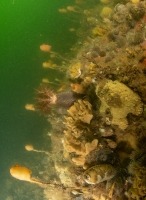
(Photo: Claire Goodwin/HMSC)

-
Wolffish Den
View species
Around the point, there are several wolffish dens. During the spring, wolfish move inshore from deeper water and occupy spaces between boulders and crevices in rock. In summer they form pairs and mate. The female lays an egg mass in the den. The male guards the eggs until they hatch in the autumn. While they are paired or guarding eggs, wolffish do not feed.
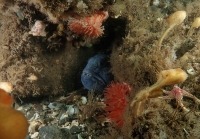
(Photo: Connie Bishop)

-
Animal Covered Boulder
In shallow water, seaweeds dominate the seabed. In deeper water, there isn’t enough light for seaweeds to photosynthesize, and animals become dominant. On rocky seabeds, sponges are one of the most common groups. They can be hard to identify, and of an estimated 15,000 existing sponge species, we think around half haven’t yet been scientifically described. Huntsman researchers have been surveying the area around Deer Island to learn more about the species present here.
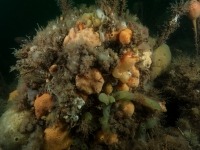
(Photo: Connie Bishop)

-
Sea Potatoes
View species
Sea potatoes form dense forests around Deer Island Point. They favour areas like these with high currents as they provide lots of food. They feed on small particles in the seawater, including plankton and detritus. They take in water through their inhalant siphons (the hole on the side of the sea potato). They then trap particles from the seawater in a mucus net that lines their pharynx (throat). Afterward, they eject the water from the exhalant siphon (hole) on the top of their body.
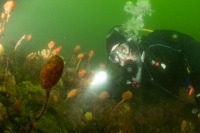
(Photo: Claire Goodwin/HMSC)

-
Deer Island Light
Deer Point Light stands 6.1 metres tall and flashes red for 2 seconds every 12 seconds. It is not officially a lighthouse as it doesn’t have an enclosed lamp room and never had a keeper. Yet it is still an important navigational marker for vessels operating in these waters.
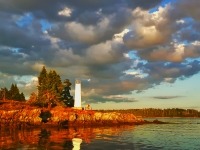
(Photo: Farley Pat Mowatt)

-
Newfoundland Lumpsucker
View species
SCUBA divers are sometimes lucky enough to spot the Newfoundland lumpsucker when exploring around Deer Island Point. You have to have eagle eyes to spot these rather cute fish. Not only are they tiny, but their colours can camouflage them against the bright sponges and seaweeds they rest on.
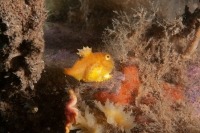
(Photo: Claire Goodwin/HMSC)

-
Hydroids and Sea Slugs
Hydroids are often abundant in areas with strong current as the water flow provides them with plenty of food. The pink heart hydroid is in the phylum Cnidaria (anemones, sea jellies, and hydroids). Animals in this phylum all have stinging cells called nematocysts. They use these to capture their prey and defend themselves. Despite these stinging cells, several species of sea slug (nudibranch) feed on this hydroid. Some of these sea slugs can take the hydroid’s nematocysts and store them in their skin to protect themselves from predators.
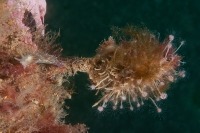
(Photo: Claire Goodwin/HMSC)

-
Sampling Sponges
Learn more
Video Description: While it is possible to identify many marine species underwater, some need closer examination. Scientists take samples to preserve and examine in the laboratory. Scientists often need to look at sponges under the microscope to identify them. Here, Huntsman researcher Claire Goodwin is sampling a sponge. She photographs the sponge, then cuts a small piece of it using a knife. Claire places the sponge in a numbered sample bag so she can match the sample to the photo. It is tricky for her to squeeze the sample into the bag as she is wearing thick gloves to protect her hands from the cold water. We can hear the exhalations of the cameraman and the soft whir of the boat engine above us.
-
Tagging Wolffish
View species
Researcher Kaleb Zelman, of the Maliseet Nation Conservation Council (MNCC), holds an Atlantic wolffish. SCUBA divers have carefully brought it up to the surface. Kaleb will tag it with an acoustic tag, and graduate student Chandler Stairs will collect tissue samples. They will then release the wolffish back into its habitat. The scientists will then be able to track its movements using a receiver. Stable isotope analysis of the tissue samples will help them determine what it is feeding on. This will lead to improved understanding of the biology of this endangered species. MNCC is conducting this research in partnership with the research lab of Dr. Charles Sacobie. Charles is a Wolastoqey (Maliseet) fish physiologist at the University of New Brunswick. Fisheries and Oceans Canada provide funding.

(Photo: Chandler Stairs)

-
Sea Potato Forest
View species
Many areas around Deer Island Point are too deep and dangerous for scientists to survey them by SCUBA diving. At this site, Fisheries and Oceans researchers used a drop camera system to record what is present on the seabed. There are dense forests of sea potatoes.
Video Description: It is hard to see the seabed through the dark, silty water. Many particles are rushing by in the current. We see the weight from the camera frame dangling down. Sometimes it brushes the sea potatoes that crowd the seabed. This video has no sound.
-
Sea Potatoes
View species
Sea potatoes are found in areas with strong tides – like this site. They provide an important habitat for other animals. Their long stems are easily ripped up from the seabed, so they can be damaged by bottom fishing. Numbers in the Bay of Fundy have significantly declined in recent years.
Video Description: Particles whisk past, carried through the green water by a strong current. The long stems of the sea potato sea squirts bend and sway. Their globular bodies bob. We can hear the engine of the boat up ahead, and the tinkling of bubbles as the cameraman exhales.
-
Filter Feeders
Many of these animals feed on particles from the seawater. The sea cucumber is a suspension feeder. It uses its branched tentacles to catch floating plankton. The sponges are filter feeders. They suck water into a network of chambers in their body. They mainly feed on tiny particles <0.5 micrometres in diameter. Horse mussels are also filter feeders that extract bacteria, phytoplankton, detritus, and dissolved organic matter using their gills.
Video Description: We see the seabed relatively close up. Before us (from left to right) we see a northern red anemone, a sheep’s tongue sponge, and an orange-footed sea cucumber. Around the cucumber are horse mussels. Most of the feathery arms of the sea cucumber waft in the current but one is in its mouth. As we watch, the sea cucumber slowly pulls the arm out of its mouth. It then starts to place another arm in. We can hear the exhalations of the cameraman as he observes.
-
Underwater Cliff
Video Description As the camera pans down the underwater cliff, we can see that life packs every inch of it. There are sponges, such as the globular yellow sheep’s tongue sponge and finger-like Deichmann’s sponge, and large northern red anemones. Sponges cover many northern lamp shells. As we reach the base of the wall, there are clusters of horse mussels. We spot a lobster, retreating into a small cave. We can hear the tinkling of bubbles as the cameraman exhales.
-
Horse Mussel Bed
Horse mussels can reach densities of 158 mussels per square metre in the Bay of Fundy. Horse mussel beds provide shelter, nurseries for young, and feeding grounds for many species, including commercially important species such as scallops.
Video Description: At the base of the rocky underwater cliffs at Deer Island Point the seabed is carpeted with horse mussels. The camera pans, close to the seabed. We can see the yellow mantles of the mussels coming out of their gaping shells. Many hydroids are growing on the mussels and some large Deichmann’s sponges. Some large blood stars drape over the mussels. We can hear the tinkling of bubbles as the cameraman exhales.
-
New Sponge Species 1
View species
This encrusting sponge is a species new to science. Huntsman researcher Claire Goodwin discovered it at Deer Island Point in 2016 and called it Crellomima mehqisinpekonuta The type locality (where the type specimen was found) is in the traditional territory of the Peskotomuhkati Nation. Its scientific name is from the Peskotomuhkati Mehqi-sinpekonut meaning something “reddish-orange (animate) that gets water squeezed out of it.” The Peskotomuhkati language committee provided the name. When giving Latin names to species we have to follow the rules set out in the International Code of Zoological Nomenclature. Taxonomists often name species after their physical characteristics or in honour of people or places. There isn’t any rule against naming a species after yourself, but it is considered vain so isn’t done very often.
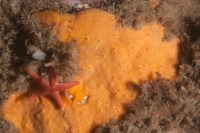
(Photo: Claire Goodwin/HMSC)

-
New Sponge Species 2
View species
The main character we use for identifying sponges is their skeleton. Sponges have a skeleton made of spongin protein fibres and spicules, which are tiny glass or calcium carbonate pieces with a variety of intricate shapes. To identify sponges, we look at the shape of the spicules and measure their size. We compared the chelae spicules of our new species, Crellomima mehqisinpekonuta, to other species in the genus Crellomima and found differences. Because the chelae spicules are tiny, we had to use a scanning electron microscope to see their shape.
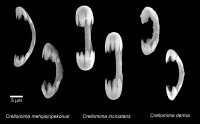
(Photo: Claire Goodwin/HMSC)

-
New Sponge Species 3
View species
When a taxonomist (a scientist who works to name, describe, and classify organisms) describes a new species, they have to designate one specimen as the holotype. The holotype is the specimen on which the taxonomist has based their description. The holotype specimen must be placed in a recognized museum so that it is available for others to examine in the future. The holotype specimen for Crellomima mehqisinpekonuta is in the Atlantic Reference Centre (ARC) museum. When we were describing our new species, we borrowed the types of the other specimens in the genus Crellomima to compare it to. These came from museums in the United Kingdom, Germany, and Russia.

(Photo: Claire Goodwin/HMSC)

-
New Sponge Species 4
View species
The taxonomist must publish a written description of their new species. They normally publish this in a scientific journal. The description gives details of the characteristics of the new species. It also states how the species is different from other similar species, and gives information on the meaning of its Latin name.
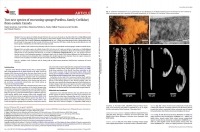
(Photo: Claire Goodwin/HMSC)


